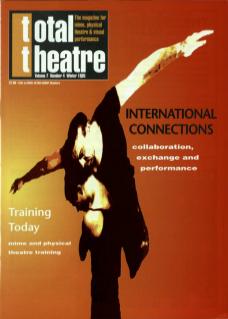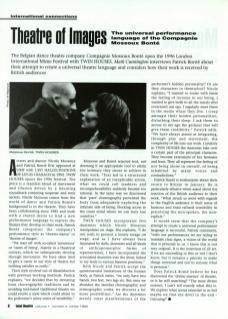Actress and dancer Nicole Mossoux and Patrick Bonté first appeared at LIMF with The Last Hallucinations of Lucas Cranach in 1992. Twin Houses opens the 1996 festival. The piece is a seamless blend of movement and illusion driven by a haunting soundtrack conjuring suspense and eerie secrets. Nicole Mossoux comes from the world of dance and Patrick Bonté's background is in the theatre. They have been collaborating since 1985 and work with a shared desire to find a new performance language to express the themes they develop in their work. Patrick Bonté categorises the company's performance style as ‘theatre-dance' or 'theatre of images'.
‘We start off with so-called “intentions” or “states of being”, mainly in a theatrical context, which we subsequently develop through movement. We have often tried to give a name to our style of theatre but nothing satisfies us really.’
Their style evolved out of dissatisfaction with previous working methods. Patrick explains: ‘We decided that by deviating from choreographic traditions and by avoiding text-based traditional theatre we could evolve a style which could attain to the performer's misty zones of sensibility.’
Mossoux and Bonté rejected text, not deeming it an appropriate tool to attain the intimacy they strove to achieve in their work. ‘Text led to a structured explanation of an inexplicable action; what we could call madness and incomprehensibility suddenly became too rational. In the same way we discovered that “pure” choreography prevented the body from adequately exploring the intimate side of being, blocking access to the inner mind where we can truly lose ourselves.’
Twin Houses incorporates five dummies which Nicole Mossoux manipulates on stage. She explains, ‘I do not wish to present a lonely image on stage, and as I have always been fascinated by dolls, dummies and all kinds of anthropomorphic forms of representation, I have incorporated the articulated dummies into the show, linked to my body in various Siamese positions.’
Both Nicole and Patrick accept the quintessential limitations of the human body, as Patrick states, ‘we only have two hands, two feet, two legs, etc. But once we abandon the familiar choreographic and mimographic codes, we discover a lot more possibilities.’ Are the dummies merely outer manifestations of the performer's hidden personality? Or are they characters in themselves? Nicole explains, ‘I wanted to evoke with them the feeling of increase in our being. I wanted to give birth to all the rascals who overcrowd our ego. I regularly meet them in the studio where they live. I creep amongst their hidden personalities, disturbing their sleep. I ask them to arouse in my ego the gestures that will give them credibility.’ Patrick adds, ‘We have always aimed at integrating, through play and movement, the complexity of life into our work. Certainly in Twin Houses the dummies take over a certain part of the principal character. They become extensions of her fantasies and fears. They all represent the feeling of not being alone in oneself, of being inhabited by many voices and contradictions.’
Patrick Bonté is enthusiastic about their return to Britain in January. He is particularly effusive when asked about the reaction of the British audience to their work. ‘What struck us most with regards to the English audience is their sense of humour and their refined sensibility in perceiving the non-spoken, the non-explicit.’
It would seem that the company's attempt to create a universal performance language is successful, Patrick comments, ‘with our performances we are trying to translate clear signs, a vision of the world that is personal to us. I know this is not very original. It is the intention of all art. If we are succeeding in this or not I don't know, but it remains a priority to make things universal and not to censure what is personal.’
Does Patrick Bonté believe he has discovered the divine essence of theatre, or is he still searching? ‘The most divine essence, I can't tell exactly what this is. We explore what seems essential to us but maybe we find the devil in the end – Grinning!’

